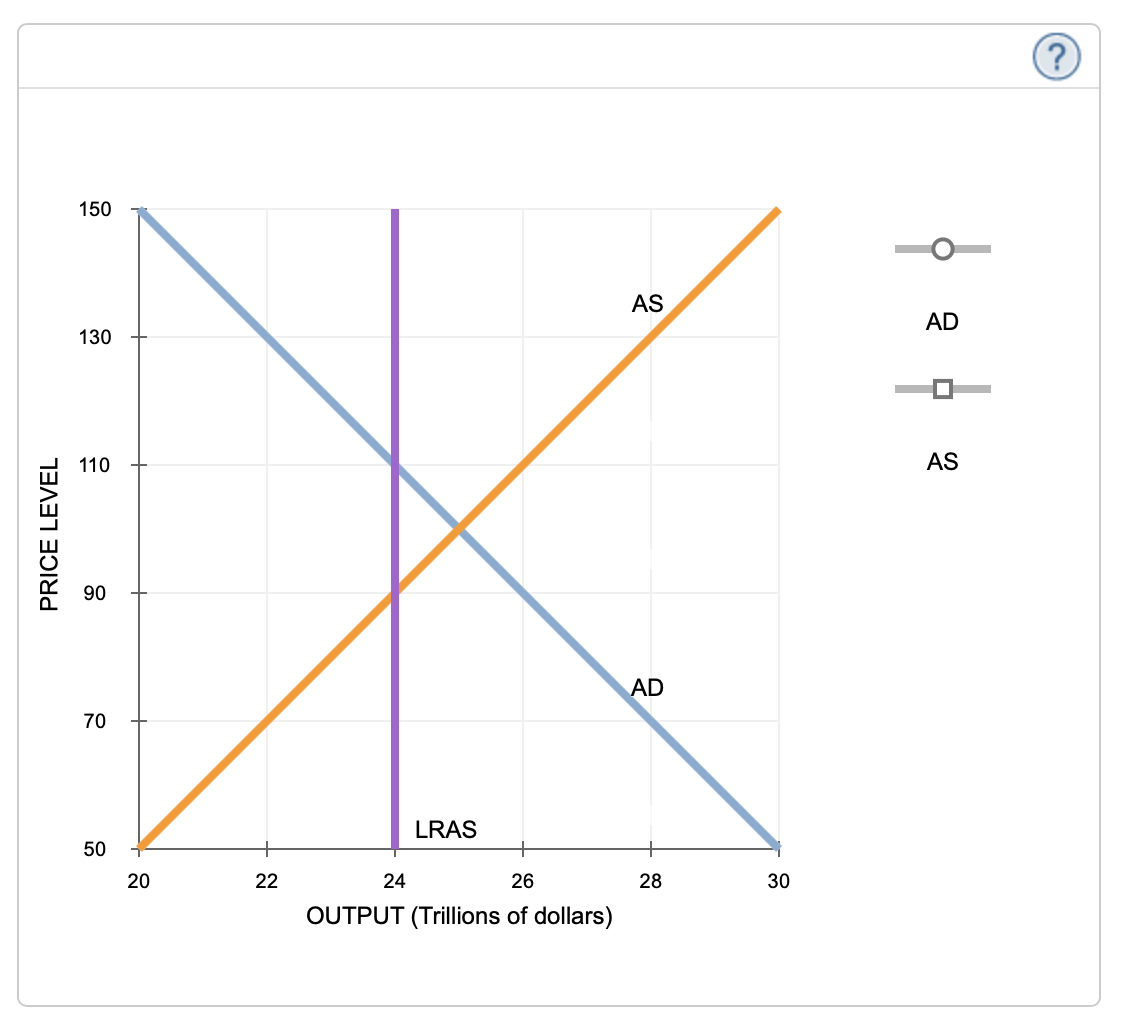Should the government use monetary and fiscal policy in an effort to stabilize the economy? The following questions address the issue of how monetary and fiscal policies affect the economy, as well as the pros and cons of using these tools to combat economic fluctuations. The following graph plots hypothetical aggregate demand (AD), short-run aggregate supply (AS), and long-run aggregate supply (LRAS) curves for the U.S. economy in February 2026. Suppose the government chooses to intervene in order to return the economy to the natural level of output by using (an expansionary/a contractionary) policy. Depending on which curve is affected by the government policy, shift either the AS curve or the AD curve to reflect the change that would successfully restore the natural level of output. Suppose that in February 2026 the government successfully carries out the type of policy necessary to restore the natural level of output described in the previous question. In July 2026, U.S. exports decrease because Europe implements trade restrictions on U.S. goods. Due to the (consumer preferences/lags/inflation) associated with implementing monetary and fiscal policy, the impact of the government's new policy will likely (decrease the long run production capcity/leave the U.S. economy unchanged/leave the economy above the natural level of output/push the economy below the natural level of output once the effects of the policy are fully realized.
Should the government use monetary and fiscal policy in an effort to stabilize the economy? The following questions address the issue of how monetary and fiscal policies affect the economy, as well as the pros and cons of using these tools to combat economic fluctuations. The following graph plots hypothetical aggregate demand (AD), short-run aggregate supply (AS), and long-run aggregate supply (LRAS) curves for the U.S. economy in February 2026. Suppose the government chooses to intervene in order to return the economy to the natural level of output by using (an expansionary/a contractionary) policy. Depending on which curve is affected by the government policy, shift either the AS curve or the AD curve to reflect the change that would successfully restore the natural level of output. Suppose that in February 2026 the government successfully carries out the type of policy necessary to restore the natural level of output described in the previous question. In July 2026, U.S. exports decrease because Europe implements trade restrictions on U.S. goods. Due to the (consumer preferences/lags/inflation) associated with implementing monetary and fiscal policy, the impact of the government's new policy will likely (decrease the long run production capcity/leave the U.S. economy unchanged/leave the economy above the natural level of output/push the economy below the natural level of output once the effects of the policy are fully realized.
Principles of Economics 2e
2nd Edition
ISBN:9781947172364
Author:Steven A. Greenlaw; David Shapiro
Publisher:Steven A. Greenlaw; David Shapiro
Chapter22: Inflation
Section: Chapter Questions
Problem 18RQ: What is deflation?
Related questions
Question
Should the government use monetary and fiscal policy in an effort to stabilize the economy? The following questions address the issue of how monetary and fiscal policies affect the economy, as well as the pros and cons of using these tools to combat economic fluctuations.
The following graph plots hypothetical aggregate demand (AD), short-run aggregate supply (AS), and long-run aggregate supply (LRAS) curves for the U.S. economy in February 2026.
Suppose the government chooses to intervene in order to return the economy to the natural level of output by using (an expansionary/a contractionary) policy.
Depending on which curve is affected by the government policy, shift either the AS curve or the AD curve to reflect the change that would successfully restore the natural level of output.
Suppose that in February 2026 the government successfully carries out the type of policy necessary to restore the natural level of output described in the previous question. In July 2026, U.S. exports decrease because Europe implements trade restrictions on U.S. goods. Due to the (consumer preferences/lags/inflation) associated with implementing monetary and fiscal policy, the impact of the government's new policy will likely (decrease the long run production capcity/leave the U.S. economy unchanged/leave the economy above the natural level of output/push the economy below the natural level of output once the effects of the policy are fully realized.

Transcribed Image Text:PRICE LEVEL
150
130
110
90
70
50
20
22
LRAS
24
26
OUTPUT (Trillions of dollars)
AS
AD
28
30
AD
0
AS
?
Expert Solution
This question has been solved!
Explore an expertly crafted, step-by-step solution for a thorough understanding of key concepts.
This is a popular solution!
Trending now
This is a popular solution!
Step by step
Solved in 2 steps with 1 images

Knowledge Booster
Learn more about
Need a deep-dive on the concept behind this application? Look no further. Learn more about this topic, economics and related others by exploring similar questions and additional content below.Recommended textbooks for you

Principles of Economics 2e
Economics
ISBN:
9781947172364
Author:
Steven A. Greenlaw; David Shapiro
Publisher:
OpenStax

Principles of Economics 2e
Economics
ISBN:
9781947172364
Author:
Steven A. Greenlaw; David Shapiro
Publisher:
OpenStax